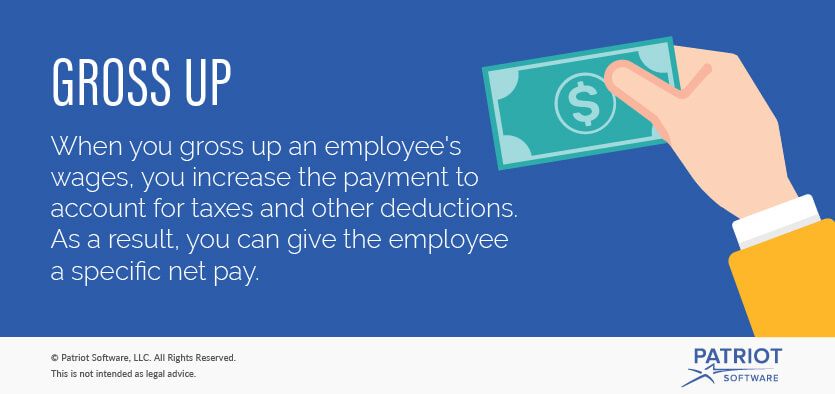Payroll
What Is a Tax Gross Up for Payroll?
There might be a time you want to pay an employee a specific amount. But, once you factor in taxes, that amount gets smaller. So how can you give an employee a certain net pay? Gross up for taxes.
Nov. 21, 2017

This article first appeared on the Patriot Software blog.
There might be a time you want to pay an employee a specific amount. But, once you factor in taxes, that amount gets smaller. So how can you give an employee a certain net pay? Gross up for taxes.
What is a gross up?
A gross up is when you increase the gross amount of a payment to account for the taxes you must withhold from the payment. Let’s say you promise an employee a specific pay amount. You will issue gross wages for more than the promised amount. After you withhold taxes from the payment, the net amount should equal the amount you promised.
The gross up basically reimburses the worker for the withheld taxes.
When to gross up payroll
You will gross up for taxes if you promise an employee that you’ll give them a certain amount. Grossing up will ensure that the employee receives that full amount even after taxes.
A tax gross up is usually used for one-time payments, such as a bonus check or relocation payment. But, you can also gross up your regular payroll. For example, if you promise an employee a take-home pay of $40,000 per year, you can gross up to make sure they actually receive that net amount.
How to gross up payroll
So, how do you do a gross up calculation? It only takes a few simple steps.
1. Add up all the tax rates that apply to the employee’s wages. This might include federal income tax, state income tax, local income tax, supplemental tax, and FICA taxes.
2. If you haven’t done so already, turn the total tax rate into a decimal. To convert a percentage to a decimal, move the decimal two places to the left. For example, if the total percentage is 35%, the decimal is 0.35.
Then, take the total tax rate (as a decimal) and subtract it from 1. This will give you the net percent.
1 – Total Taxes = Net Percent
3. Divide the net wages by the net percentage. This will give you the gross amount that you need to give the employee for them to get their promised net wages.
Net Pay / Net Percent = Gross Pay
Gross up example
Let’s say you want to give an employee a net bonus of $500.
1. Bonuses are subject to taxes. The federal supplemental tax rate is 25%. Social Security tax is 6.2%. Medicare tax is 1.45%. Let’s pretend your business and employee are in Colorado, which has a 4.63% supplemental tax rate.
Add together all the tax rates.
25% + 6.2% + 1.45% + 4.63% = 37.28%
2. Turn the total tax rate into a decimal. So, 37.28% becomes 0.3728.
Subtract the total tax decimal from 1.
1 – 0.3728 = 0.6272
3. Now, take the net pay and divide it by your result from step two.
500 / 0.6272 = 797.19
You must pay the employee $797.19 for them to receive a net bonus pay of $500.
Other calculation considerations
Even when pay is grossed up for taxes, it still might not cover all the taxes. Federal income tax has progressive tax rates. As an employee earns more, they are subject to a higher tax rate. Many states have progressive income tax rates, too.
Because of the progressive rate, you might use too low of a rate to calculate the gross up. The grossed up wages might push the wages into a higher tax bracket. When this happens, you will have to withhold more taxes, cutting into the promised net wages. Or, the employee might have to pay more taxes with their income tax return.
You also need to factor in voluntary deductions, especially when grossing up regular wages. Voluntary deductions include withholdings for health insurance or a retirement plan. These deductions might have a percentage rate or a flat dollar amount.
=======
Mike Kappel, serial entrepreneur and CEO of Patriot Software, offers payroll advice from more than 20 years of experience to small business owners.
